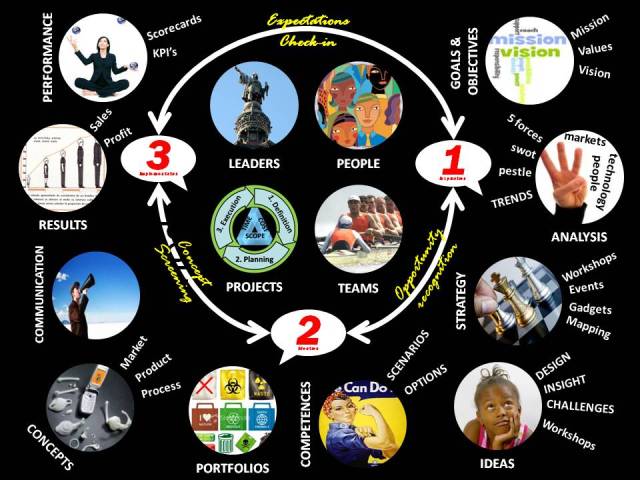 |
|
Check out the new blog of Idilia Consulting
In the new blog of Idilia Consulting, we will inform you regularly on news, novel insights and trends we spotted that may help you drive profit and volume growth.20 July 2011 at 22:00h
Is setting strategies an innovation process?
Strategy For most textbooks on the subject, strategy is about winning, about having success and about performing better than competitors, independently whether one deals with warfare, politics, sport, entertainment or business. However, according to the leadership and change authority John P. Kotter, leaders establish the vision for the future and set the strategy for getting there, reducing strategy to the plan of getting from the present to the desired situation (the vision).To the chinese general Sun Tzu ( 544-496 BC) and author of The Art of War, which is generally accepted to have been the first book on the subject, strategy meant what it meant to the ancient Greek, literally: generalship or the art of leading military operations. So, although we stretched its meaning far beyond the original military boundaries today, strategy used to be a competence, which we might call strategic leadership now, rather than a plan to get vision operational.
In his famous work Competitive Strategy (Free Press, New York, 1980 ), Michael E. Porter added the adjective competitive to stress the fact that strategy is, indeed, about winning. His book stresses the importance of analysing the competitive environment in the development of a competitive strategy, as applied to business, and has provided us with excellent and widely used concepts and techniques like generic strategies, the value chain or the five forces driving industry competition, which enhanced earlier developed tools, like SWOT or PEST(LE) analysis.
In the past decades, over 20 techniques to develop and implement competitive strategies have been introduced and improved over time. The typical tool kit for analyzing, developing and implementing strategy are: Porter’s Five Forces; Porter’s Generic Strategy Model; PESTLE; SWOT; Core Competences, Portfolio Matrices (e.g. McKinsey or BCG matrix, showing which businesses to grow and which to harvest); Scenario Planning; Key Success Factors and Resource-Based Analysis.
The introduction of (key) performance indicators and performance management tools like the balanced scorecard and strategy maps developed by Robert S. Kaplan and David P. Norton (see e.g. Kaplan R.S. and Norton D.P., The Strategy Focused Organization, HBS Press, USA, 2000) or EFQM’s Business Excellence Model, have helped us to make strategy more actionable (again).
The concept of core competences, (The core competence of the corporation, Harvard Business Review, v. 68, no. 3, pp. 79–91, 1990) introduced by C.K. Prahalad and Gary P. Hamel, has brought us a little closer to the original meaning of strategy, as a competence instead of a plan. Together with the renewed interest in leadership, rather than management, as the essential ability to get strategy developed, as well as implemented, we seem to be where we started some 25 centuries ago.
Sun Tzu’s Taoist thinking has been an inspiration long after his death, and so was John F. Kennedy’s vision of landing a man on the moon (and returning him safely to the earth), an inspiration to NASA and the whole US, yielding supremacy in the majority of technologies for decennia after his death. Indeed, leaders can motivate and inspire, but so can strategies, apart from being actionable and competitive, as they need to guide us through the risky world of warfare, politics, sport, entertainment or business.
Strategy and Innovation
A solid analysis is essential to define a successful strategy, but even the best analysis is imperfect, as future is fundamentally unpredictable. Today, with more information available than ever, and developments getting ever faster, analysis suffers increasingly from a lack of information, necessary to have full control on the outcome of our actions. So, developing and implementing strategies increasingly resembles the intuitive innovation process, where crucial information, like consumer insight data, is gathered along the way. Innovation is usually called a strategic process, but with the same right, strategic planning may be called an innovation process, as may be clear from the broad definitions of innovation that are in use (see e.g. Innovation and the Lisbon Strategy), nowadays.
In business, the central goal of strategy is creating shareholder value, which can be, in general terms, increased by growth and productivity improvement. Productivity can be improved by introducing new technologies, industrial processes or organizational insights. Growth is driven by offering new propositions (products, services, concepts, and commercial processes) to customers. In either case, innovation plays an important role, and the organization needs to develop new capabilities.
1-2-3 Action!
So, if the backbones of strategy and innovation processes are alike, we may ask ourselves whether the methods and tools developed for either purpose give rise to synergies. The affirmative answer to this question is our new service 1-2-3 Action!. The method to develop and implement strategy is inspired on IDEO’s celebrated design thinking innovation process, and is schematically represented in the following figure.
1-2-3 Action! is a cost effective and efficient method to set inspiring, actionable and competitive strategies, that deliver excellent performance. Its results and customer oriented and externally focussed approach foments teamwork, utilizes simple and effective tools, and provides a memorable learning experience to a wide range of people involved with the organization. It creates shared vision and sense of urgency, which generates the momentum necessary to obtain results fast, while initiating the change towards more participative leadership styles and innovative corporate cultures.
1-2-3 ACTION INVITADA COMO PONENTE AL “DECODING INNOVATION” EN LA SALLE BUSINESS SCHOOL - 27.2.2010
Frankwin van Dieren y Rafa Olano, socios directores de 1-2-3 Action! participaron en la mesa redonda “descifrando la innovación en las empresas”, acompañados de Ricardo Baeza de Yahoo! y Sergi Mesquida de KIM BCN, donde se trataron los siguientes temas:- What does innovation mean to you?
- How do you think organizations can generate a culture of innovation?
- What motivates people to innovate?
- How can innovation be operationalised?
3 March 2010 at 18:46h.
La innovación en la nueva década: Freddy Krueger or Dr. House?
Lejos de ser una película de terror (con un final más o menos feliz), la innovación se parece más a una serie televisiva tipo ‘Lost’ o ‘House’. Un encadenamiento de capítulos donde afloran retos, dotes de liderazgo, incertidumbres, éxitos y fracasos.Si su empresa vive en Elm Street, y quiere rodar una serie de éxito, le proponemos el siguiente decálogo:
- Tiempo. Encontrar el momento para curiosear, reflexionar, probar y aprender. Se lo pueden preguntar a Jack Bauer de la serie ‘24’.
- Diversidad. La creatividad se basa en la recombinación de elementos conocidos, a mayor heterogenia de personas y competencias, mayor originalidad de los resultados. Como el Equipo A.
- Retos. Los equipos de trabajo necesitan organizarse en base a desafíos, retos creativos con objetivos bien definidos. Igual que ‘Los hombres de Harrelson’.
- Liderazgo. Los proyectos grandes y pequeños requieren de una visión clara y un líder que facilite el llegar a resultados satisfactorios. Como Jean-Luc Picard en ‘Star Trek’, liderando el descubrimiento de nuevos mundos.
- Estructura. Las jerarquías que tanto ayudan a la operativa diaria deben adaptarse a los procesos de innovación, difuminando barreras interdepartamentales como hace el Dr. House.
- Tolerancia al fracaso. Innovar es arriesgado. La empresa innovadora no castiga el fracaso, penaliza la inacción. Son procesos de aprendizaje, parecidos a los que sufre el ‘Inspector Gadget’.
- Reconocimiento. Las recompensas (más o menos generosas), o el simple reconocimiento muestra el compromiso de la dirección y aumenta la motivación de las personas. También del mejor amigo de la policía, ‘Rex’.
- Gestión del conocimiento. No hay que reinventar la rueda constantemente, aprovechar la sabiduría y el talento de los empleados para acelerar la innovación. Como el equipo de ‘CSI’ cada vez que se enfrenta a un nuevo caso.
- Espacio físico y virtual. El lugar de trabajo, los espacios comunes, la intranet, no pueden ser agujeros negros, si no auténticos “hubs” de innovación. Realmente inspiradora la serie ‘Fama’, con todas esas interacciones en el ámbito de la escuela.
- Conversaciones. Extramuros, cabe observar y escuchar mejor a clientes, no-clientes, y otras empresas dispuestas a colaborar. Intramuros, escuchar activamente y construir sobre las ideas de los demás. Un poco, como John Locke en ‘Lost’.
15 january 2010 at 17:50h.




